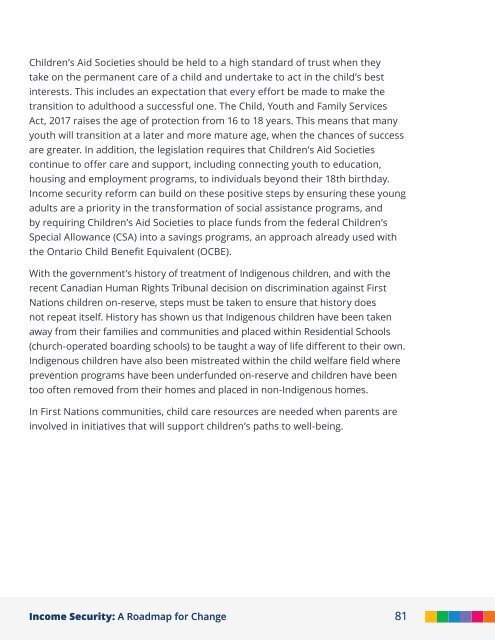Income Security: A Roadmap for Change
You also want an ePaper? Increase the reach of your titles
YUMPU automatically turns print PDFs into web optimized ePapers that Google loves.
Children’s Aid Societies should be held to a high standard of trust when they<br />
take on the permanent care of a child and undertake to act in the child’s best<br />
interests This includes an expectation that every ef<strong>for</strong>t be made to make the<br />
transition to adulthood a successful one The Child, Youth and Family Services<br />
Act, 2017 raises the age of protection from 16 to 18 years This means that many<br />
youth will transition at a later and more mature age, when the chances of success<br />
are greater In addition, the legislation requires that Children’s Aid Societies<br />
continue to offer care and support, including connecting youth to education,<br />
housing and employment programs, to individuals beyond their 18th birthday<br />
<strong>Income</strong> security re<strong>for</strong>m can build on these positive steps by ensuring these young<br />
adults are a priority in the trans<strong>for</strong>mation of social assistance programs, and<br />
by requiring Children’s Aid Societies to place funds from the federal Children’s<br />
Special Allowance (CSA) into a savings programs, an approach already used with<br />
the Ontario Child Benefit Equivalent (OCBE).<br />
With the government’s history of treatment of Indigenous children, and with the<br />
recent Canadian Human Rights Tribunal decision on discrimination against First<br />
Nations children on-reserve, steps must be taken to ensure that history does<br />
not repeat itself History has shown us that Indigenous children have been taken<br />
away from their families and communities and placed within Residential Schools<br />
(church-operated boarding schools) to be taught a way of life different to their own<br />
Indigenous children have also been mistreated within the child welfare field where<br />
prevention programs have been underfunded on-reserve and children have been<br />
too often removed from their homes and placed in non-Indigenous homes<br />
In First Nations communities, child care resources are needed when parents are<br />
involved in initiatives that will support children’s paths to well-being<br />
<strong>Income</strong> <strong>Security</strong>: A <strong>Roadmap</strong> <strong>for</strong> <strong>Change</strong> 81
















